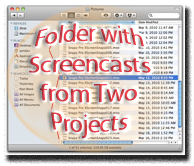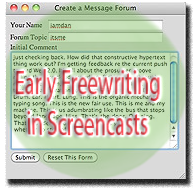23 Files
 Toward the end of “Watch the
Bubble,” the narration notes that the version used in the video is the
twenty-third take. This is incorrect. It's impossible to determine the
precise number of takes since many incomplete recordings have been
discarded. Additionally, the number of “complete” takes for the project
is actually thirteen. The total count referenced in the
narration also includes those from the earlier project, “I'm a Map.” It's
clear that the two projects share much, but it is inaccurate to say that the
first ten takes are iterations of the bubble recordings. Still, the miscounting of the
number of video captures speaks to the way the bubble emerges from the map.
Toward the end of “Watch the
Bubble,” the narration notes that the version used in the video is the
twenty-third take. This is incorrect. It's impossible to determine the
precise number of takes since many incomplete recordings have been
discarded. Additionally, the number of “complete” takes for the project
is actually thirteen. The total count referenced in the
narration also includes those from the earlier project, “I'm a Map.” It's
clear that the two projects share much, but it is inaccurate to say that the
first ten takes are iterations of the bubble recordings. Still, the miscounting of the
number of video captures speaks to the way the bubble emerges from the map.
The final script maintains the reference to twenty-three takes mainly because that observation, though incorrect, is also right for the project. The number emerged in the idea stream as the many iterations were practiced, performed, recorded, discarded, or saved. The ten early videos and the thirteen new captures push twenty-three into the script. The rhythm of the prose reflects the fit. I can't imagine composing a phrase like “the thirteenth take of a ten-minute moment,” because “the twenty-third take of a ten-minute moment” bubbled right into the mix.
Credit the hyperiteration of the project. Each saved capture represents a number of practice sessions, false starts, refinements, and improvisations. In the earlier stages, I was more prone to saving these recordings in an attempt to capture the invention taking place in the performance. Other captures acted more as practice sessions for future performances and would be stopped and discarded at multiple points along the way. Later captures were saved more frequently as “almost there” moments.

In concert with these iterations, we find repetitions and revisions of the composing moves. In the earliest takes, for instance, the typing was spontaneous, emerging with the rhythm of the backing sounds and pulling from ideas floating in my head from multiple projects. Capture 11 and captures 13-16 all represent spontaneous prose performed during the screen recordings. By capture 17, I had made an adjustment and concretized a script for the typing. To enable typing of the script while the screen recorder played, I loaded the script into a text editor and used the text-to-speech feature. In the final version of the text file with the typing script I had to embed pauses so that my typing could keep up with the machine reading. As the text-to-speech played in my earphones, this is what I heard as I typed:
After capture 17, I used the spoken script to enable the “spontaneous” typing. This development brought some additional layers of complexity to the performance itself. I placed the text file with the talking typing script on a separate laptop and prepared it for playing. This was necessary because performing the capture with the music in the background precluded playing the text-to-speech on the computer on which I was recording the project. I continued to practice, perform, and capture the basic moves on one machine, but in the middle of the performance I would jump to my laptop and switch on the text-to-speech to enable me to keep typing in the recorded performance. The text-to-speech software would perform the script I had written, and I would subsequently type the emerging text into a Web browser while the screen capture recorded the action.